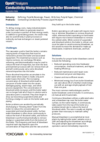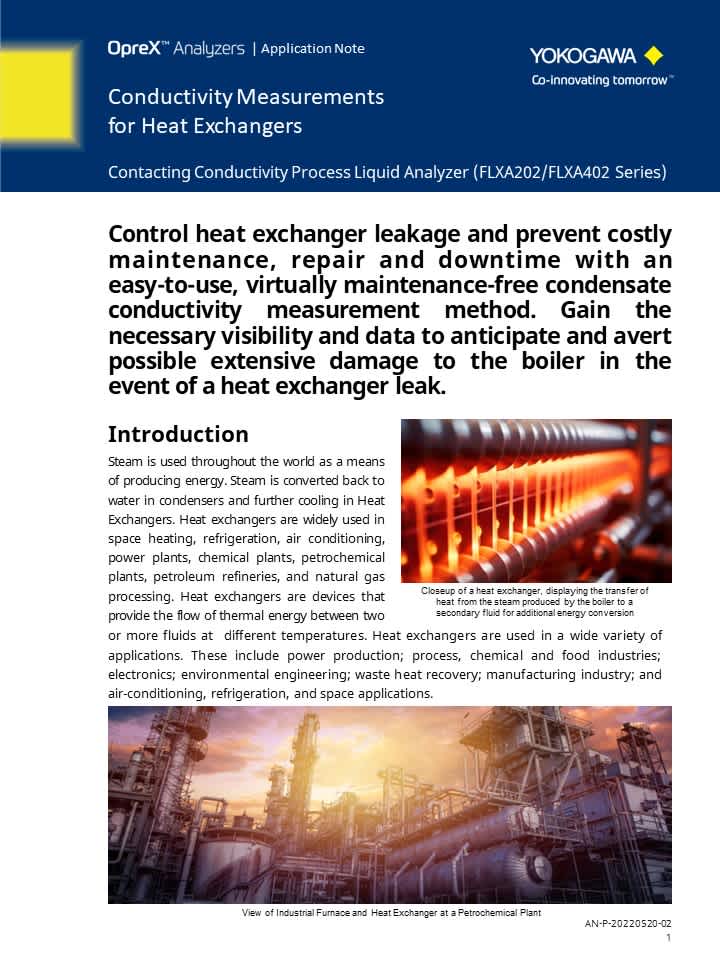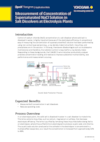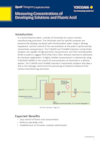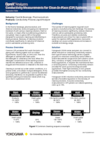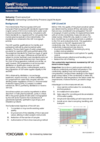How Is Conductivity Measured?
Conductivity sensors and electrodes are used to measure process conductivity, resistivity, WIFI, demineralizer water, RO water, percent concentration, boiler blowdown, and TDS. Various installation options include retractable, flow thru, immersion, and direct insertion. Proper electrode/sensor selection is critical for optimal measurement results.
What Is Conductivity?
Conductivity is the measurement of the solution or substance’s ability to carry or conduct an electric current. Conductivity sensors are used to measure conductivity in aqueous solutions to determine the purity or impurity of a liquid.
An electric current will flow through liquids when a voltage difference exists between two points; the presence of ions or charged particles are necessary as they are the “carriers” of the current flowing through the solution. If there are no ions present in the liquid, such as with ultrapure water, then no current can flow and the solution is not conductive.
However, if the water is not ultrapure, then ions are present and electric current can flow through the solution (e.g. brine solution), detectable by water conductivity sensors. The same is true for chemical solutions such as HCl.
How to Select Conductivity Sensors?
There are two basic sensor styles used for measuring Conductivity: Contacting and Inductive (Toroidal, Electrodeless).

Contacting
Contacting conductivity sensors are ideal for use in pure and ultrapure water applications. They are highly sensitive to ions present, providing the highest accuracy for low conductivity measurements.

Inductive (Toroidal, Electrodeless)
Inductive conductivity sensors have a wide range capability and are better suited for measurements in dirty, corrosive, or high conductive solutions, requiring less maintenance than contacting sensors in the same environment.
Selecting a Conductivity Sensor
|
|
Applications |
|||||
|---|---|---|---|---|---|---|
|
|
||||||
|
Contacting Sensors |
|
|||||
|
SC42 Large Bore |
x |
|
x |
|
|
|
|
SC42 Small Bore |
x |
x |
|
|
|
|
|
SC4A |
x |
|
|
|
|
|
|
SX42 |
|
x |
|
|
|
|
|
SC72 |
|
|
|
|
|
x |
|
Inductive Sensors |
|
|||||
|
ISC40 |
|
|
x |
x |
x |
|
-
Pure Water (Low) Conductivity Sensors SC4A/SC42
Intended for low conductivity applications
-
Sanitary/Hygienic Conductivity Sensors
Suitable for steam sterilization or CIP cleaning
-
High Pressure, High Temperature Conductivity Sensors SC42/SX42
Designed for high pressure, high temperature applications
-
Toroidal/Inductive Conductivity Sensor ISC40
Superior conductivity measurement reliability, accuracy, and rangeability
-
Percent Concentration Sensors ISC40
Measure accurately in rinse water or concentrated acids
-
Portable Conductivity Meter SC92
Tough and easy-to-use portable conductivity meter (SC meter) that can measure a wide range of conductivity from pure water to seawater. For your daily measurement partner.
-
Portable Conductivity Handheld Meter SC72
Ideal for field use
-
High Conductivity Sensors ISC40/SC42
Precision sensors and instruments for extreme conditions
-
Product Finder
This web tool makes it easier to find products according to the application, measurement conditions and required specifications.
Details
What Is Conductivity?
Conductivity is the measure of a solution's ability to pass or carry an electric current. The term conductivity is derived from Ohm's Law, E=I•R; where Voltage (E) is the product of Current (I) and Resistance (R); Resistance is determined by Voltage/Current. When a voltage is connected across a conductor, a current will flow, which is dependent on the resistance of the conductor. Conductivity is simply defined as the reciprocal of the resistance of a solution between two electrodes.
How Is Conductivity Measured?
There are two basic sensor styles used for measuring Conductivity: Contacting and Inductive (Toroidal, Electrodeless).
When Contacting Sensors are used, the conductivity is measured by applying an alternating electrical current to the sensor electrodes (that together make up the cell constant) immersed in a solution and measuring the resulting voltage. The solution acts as the electrical conductor between the sensor electrodes.
With Inductive (also called Toroidal or Electrodeless), the sensing elements (electrode coils) of an inductive sensor do not come in direct contact with the process. These two matched (identical coils) are encapsulated in PEEK (or Teflon) protecting them from the adverse effects of the process.
What Makes a Solution Conductive?
Ions present in the liquid (Na, Ca, Cl, H, OH) are responsible for carrying the electric current an electrical conductivity sensor detects.
Conductivity is only a quantitative measurement: it responds to all ionic content and cannot distinguish particular conductive materials in the presence of others. Only ionizable materials will contribute to conductivity; materials such as sugars or oils are not conductive.
Conductivity applications cover a wide range from pure water at less than 1x10-7 S/cm to concentrated solutions with values greater than 1 S/cm. Such application examples are WIFI, demineralizer water, RO water, percent concentration, boiler blowdown, and TDS.
In general, the measurement of conductivity is a rapid and inexpensive way to determine the ionic strength of a solution. Water conductivity transmitters use conductivity to measure the purity of water or the concentration of ionized chemicals in water. It is a nonspecific technique, unable to distinguish between different types of ions, giving instead a reading that is proportional to the combined effect of all the ions present.
The accuracy of the measurement is strongly influenced by temperature variations, polarization effects at the surface of the contacting electrodes, cable capacitances, etc.
Yokogawa has designed a full range of precision water conductivity controllers, sensors, and instruments to cope with these measurements, even under extreme conditions.
Industrial Applications of Conductivity Sensors
- Conductivity Measurements for Boiler Blowdown
- Cooling Towers
- Edible Fat and Oil Processing
- Conductivity Measurements for Heat Exchangers
- Salt Dissolvers at Electrolysis Plants
- Conductivity Measurements for Clean-in-Place (CIP) System
- Conductivity Measurements for Pharmaceutical Water
- Brine Manufacturing
- Measuring Concentrations of Developing Solutions and Fluoric Acid
- Liquid Analyzer Measurements for Reverse Osmosis
How To Select The Right Sensor?
When selecting an industrial conductivity sensor probe for an application, consider the following:
- What is the measurement range? (This dictates which cell constant will be required).
- What is the process temperature? (We have standardized on Pt1000)
- What is the chemical makeup of the process? (This determines what material of construction we offer to ensure chemical compatibility).
What is a cell constant, and why do we need to be concerned about it?
The cell constant is mathematical value for a "multiplying factor" that is used to determine the measuring range of the sensor. This mathematical value is determined by the geometric design of the cell. It is calculated by dividing the distance (length) between the two measuring plates by the area of the plates (area of the plates is determined by the area of the outside-the area of the inside = area between the electrodes).
The raw conductivity value is then multiplied by the cell constant which is why we see the unit µS (micro siemens)/cm.
Yokogawa offers four cell constants: 0.01, 0.1, 1.0, and 10.0, which provide accurate of the entire Measurement range of 0-2,000,000 µS. These values are known as the nominal cell constant, whereas the printed cell constant on the sensor can vary slightly (you will see 0.0198 instead of 0.02) is the specific cell constant for that sensor.
One of the problems that occur when an incorrect cell constant is used is Polarization.

The first example shows a solution with the correct cell constant where the ions are free to travel from one plate to the other.

The second example shows the same cell constant being used in a highly conductive solution. When the voltage alternates (switches polarity), the ions cannot freely move to the other plate because the ion density is too high. This results in fewer ions contacting the correct plate which will result in a false low reading.
However, for the ISC40 Inductive Sensor, there is only one cell factor (constant). It covers the entire conductivity measurement range 0-2,000 S/cm. But on only the low end (below 50µS) does the accuracy of the sensor suffer.
Resources
To defray energy costs, many industrial plants have their own boilers to generate steam to produce a portion of their energy needs. In addition to generating power, the steam may also be used directly in plant processes or indirectly via heat exchangers or steam jacketed vessels.
Heat exchangers are devices that provide the flow of thermal energy between two or more fluids at different temperatures. Heat exchangers are used in a wide variety of applications. These include power production; process, chemical and food industries; electronics; environmental engineering; waste heat recovery; manufacturing industry; and air-conditioning, refrigeration, and space applications. Yokogawa offers a means to control heat exchanger leakage and prevent costly maintenance, repair and downtime with an easy-to-use, virtually maintenance-free condensate conductivity measurement method.
Conductivity measurement can be used as a reliable indicator of the real-time brine concentration. Using an online process analyzer removes the need for timely grab sample analysis.
Control of sodium chloride (NaCl) concentration at a salt dissolver where solid salt is dissolved in water, is highly important because of the electrolysis efficiency. A conventional way of measuring the concentration of supersaturated NaCl solution had been performed by using non-contact type sensors (e.g., γ-ray density meter) since NaCl, impurities, and precipitates are in the solution.
In a semiconductor plant, a variety of chemicals are used in various manufacturing processes. The chemicals used for specific purposes are produced by diluting raw liquid with demineralized water using in diluting equipment, and the control of the concentration at this point is performed by conductivity measurement.
Clean-in-place (CIP) is the system designed for automatic cleaning and disinfecting in the food & beverage, pharmaceutical, and chemical industries. Tanks and piping are cleaned and sterilized with various cleaning solutions, fresh or hot water, or steam after manufacturing products is completed.
Reverse osmosis (RO) is a separation process that uses pressure to force a solution through a membrane that retains the solute on one side and allows the pure solvent to pass to the other side. More formally, it is the process of forcing a solvent from a region of high solute concentration through a membrane to a region of low solute concentration by applying a pressure in excess of the osmotic pressure.
Yokogawa’s Process Liquid Analyzers series help pigment producers achieve a more reliable and accurate analysis of pH during industrial bioprocesses, improving product quality with less total operation costs.
The kraft process, also known as kraft pulping or the sulfate process, is a technology for conversion of wood into wood pulp that consists of almost pure cellulose fibers. Today, the kraft process is used in approximately 80% of paper production.
Yokogawa’s conductivity transmitters and converters possess USP functions that make this seemingly complex and troublesome requirement pain-free and automatic.
There are numerous industrial applications where measurements and/or control of a specific chemical strength of the process is critical for optimizing the production of the end product. These specific concentrations are obtained by mixing a full strength solution with water to achieve the desired percent concentration.
Downloads
General Specifications
Technical Information
Videos
Installing the sanitary fitting on an ISC40 sensor. While we strive to provide the most safe and accurate information possible, we are not responsible for any loss or damages resulting from attempting to replicate the acts conducted in this video. Furthermore, we shall not be held liable for use or misuse of information contained in this video.
In this 40 min session you will learn the fundamental requirements for aqueous conductivity measurements; the differences between "Contacting" and "Inductive" measurement techniques and which one to use for a particular application. As well as learn the importance of online diagnostics. The goal is to provide participants with simple techniques they can implement to improve their day to day operations and to identify causes of errors and how to correct them
Looking for more information on our people, technology and solutions?
Contact Us